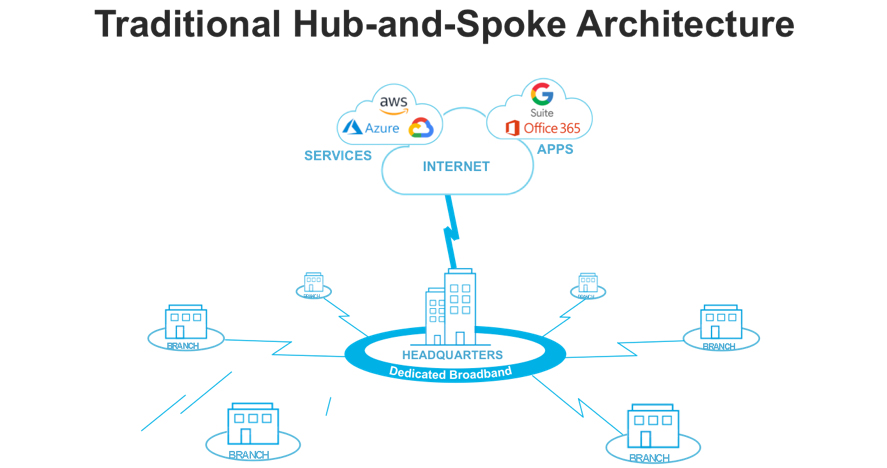What is Gartner SASE?
The secure access service edge (SASE, pronounced sassy) is a networking model first described by Gartner in 2019. It marks the necessary merger of traditional WAN management and security capabilities into a unified whole, one that is built, implemented and managed using cloud-native architectures.
The Gartner SASE model is a response to the limitations of conventional networking and security architectures in keeping pace with emerging edge-centric trends in mobility, cloud, SD-WAN and the Internet of Things (IoT). Conventional networking architectures are often over-reliant on physical infrastructure and suffer from tool proliferation, solution silos, manual processes and lack of automation. Their rigid hub-and-spoke arrangements route all endpoints through a central data center (Fig. 1), which results in performance issues at the network edge. Together, these shortcomings can hinder an organization’s flexibility, agility and ability to scale up its network.
Figure 1. Conventional hub-and-spoke architectures cannot keep pace with the escalating demands of edge-centric computing.
Benefits of SASE Networks
Increasingly, business applications and workloads are moving to the cloud. In addition, with the rise of BYOD and cloud connectivity, the traditional network security perimeter has vanished. The Gartner SASE framework reflects this rapidly changing network landscape.
In a SASE network, the burden of managing and securing a network moves from labor-intensive, server-based appliances in the data center to virtual and containerized applications in the cloud. As a result, SASE networks enable organizations to:
- Simplify management
- Scale elastically
- Dynamically deploy networking and security capabilities as needed
- Consume versatile network and security capabilities as cloud-based applications
Characteristics of the Gartner SASE Model
Gartner SASE requires technology and service providers to bring to market new platforms and architectures that enable organizations to deliver and manage network and security services with more agility and at ever-increasing scale. Primary elements of SASE networks include:
- Cloud-native architectures with containerized micro-services—use of cloud-native design principles and containerization for superior agility, flexibility, speed and scalability
- Integrated network and security services—simplified management of diverse WAN networking and security services available through a common platform
- Cloud-managed on-demand services—combining the cloud with consumption-based usage in delivering elastically scalable networking and security services to globally distributed, edge-centric enterprises
- Centralized policy control—a unified framework for deploying and enforcing security policies to all devices and endpoints across the network
- Local survivability—maintaining local access to essential network services such as DNS at the branch level should a disruption in WAN connectivity to headquarters occur
Importance of Cloud-Native Design in SASE Networks
The Gartner report stresses the need for SASE network components built using cloud-native principles. As the number and complexity of services increases, and the number of connected devices expands, architectures that are not cloud-native will be unable to scale to the necessary level and will become too expensive, slow to update and resource intensive.
LEARN MORE ABOUT GARTNER SASE AND RELATED TECHNOLOGIES
- SANS 2023 Survey: Visibility and Attack Surface – White Paper
- The Rise of SASE and Cloud-Native Networking and Security, Featuring Research from Gartner – White Paper
- Infoblox for SD-WAN – Solution Overview
- BloxOne DDI for Office 365 – Solution Note
FROM THE INFOBLOX COMMUNITY
ABOUT INFOBLOX
Infoblox unites networking and security to deliver unmatched performance and protection. Trusted by Fortune 100 companies and emerging innovators, we provide real-time visibility and control over who and what connects to your network, so your organization runs faster and stops threats earlier.
